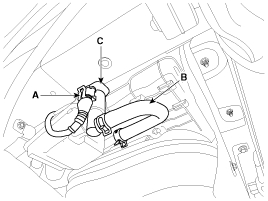 Kia Sedona: Canister Close Valve (CCV) Repair procedures
Kia Sedona: Canister Close Valve (CCV) Repair procedures
Third generation YP (2014-2025) / Kia Sedona YP Service Manual / Engine Control / Fuel System / Engine Control System / Canister Close Valve (CCV) Repair procedures
| Inspection |
| 1. |
Turn the ignition switch OFF. |
| 2. |
Disconnect the CCV connector. |
| 3. |
Measure resistance between the CCV terminal 1 and 2. |
| 4. |
Check that the resistance is within the specification.
|
| 5. |
Disconnect the vapor hose connected with the canister from the CCV. |
| 6. |
Connect a vacuum pump to the nipple. |
| 7. |
Ground the CCV control line and apply battery voltage to the CCV power supply line. |
| 8. |
Apply vacuum and check the valve operation.
|
| Removal |
| 1. |
Turn the ignition switch OFF and disconnect the battery negative (-) cable. |
| 2. |
Lift the vehicle. |
| 3. |
Disconnect the canister close valve connector (A). |
| 4. |
Disconnect the ventilation hose (B) from the fuel tank air filter and canister close valve. |
| 5. |
Remove the canister close valve (C).
|
| Installation |
Note that internal damage may occur when the component is dropped. In this case, use it after inspecting. |
| 1. |
Install in the reverse order of removal. |
 Canister Close Valve (CCV) Schematic Diagrams
Canister Close Valve (CCV) Schematic Diagrams
Circuit Diagram
...
Other Information:
Repair procedures
Adjustment
How To Initialize
1.
Check that the glass is installed.
•
Finished height adjustment.
2.
Push UP the switch. (Keep holding the switch.)
3.
Release the sunroof UP b ...
Coolant Repair procedures
Replacement And Air Bleeding
Never remove the radiator cap when the engine is hot. Serious
scalding could be caused by hot fluid under high pressure escaping from
t ...
Categories
- Home
- First Generation
- Second Generation
- Third generation
- Kia Sedona YP 2014-2025 Owners Manual
- Kia Sedona YP 2014-2025 Service Manual
Copyright © www.kisedona.com 2016-2025



